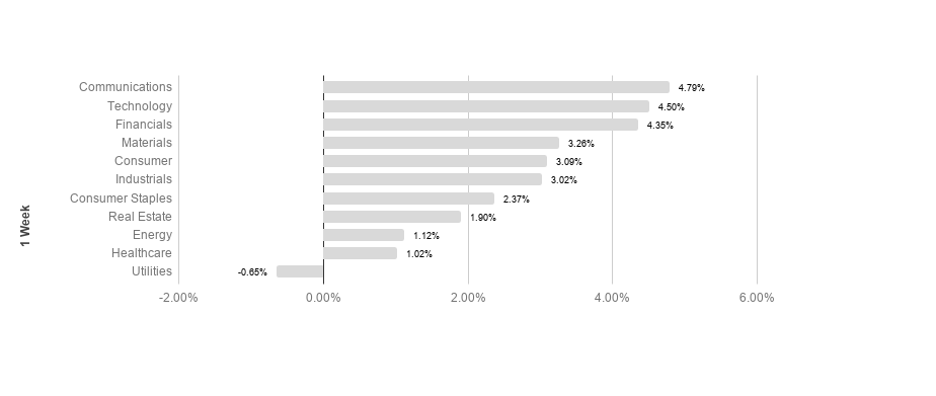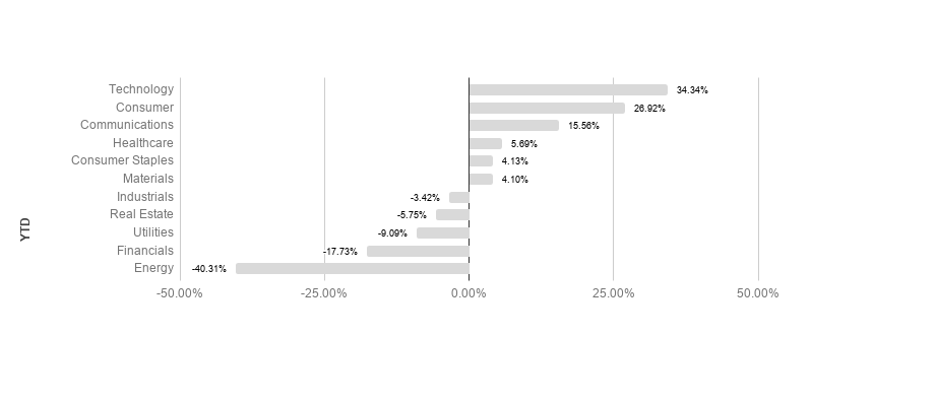Stocks rose this week as durable goods numbers beat expectations, helping propel the S&P 500 to close at fresh all time highs on Friday. Another week of solid economic data helped support stock prices and push up treasury yields. Also helping reassure investors was a decline in tensions with China, as both sides reportedly held constructive talks during the week surrounding trade obligations under the current trade deal. Unemployment claims are likely to remain elevated for several more weeks, and the unemployment rate remains at the second highest level in history. The persistently high case rate of COVID-19 in the U.S. remains concerning, but infection rates seem to be slowly but steadily decreasing. Congress is still attempting to pass a second round of stimulus, but the Democrat controlled House and Republican controlled Senate remain in challenging negotiations. To cap off the week, Fed Chair Powell delivered a speech on Thursday outlining a significant shift in monetary policy moving forward, declaring that the Federal reserve would be pursuing a long term inflationary target that would permit for periods of higher than ideal inflation to make up for periods of low inflation.
Overseas, developed markets rose as global optimism has increased. Most major European indices returned positive results for the week. Japanese equities returned slightly negative performance. As global economies continue to work towards business as usual, analysts are hoping Covid-19 infections are brought further under control so that focus can dial in more on global recovery efforts.
Markets gained this week, with equity indices bringing in solid returns. Fears concerning global stability and health are an unexpected factor in asset values, and the recent volatility serves as a great reminder of why it is so important to remain committed to a long-term plan and maintain a well-diversified portfolio. When stocks were struggling to gain traction last month, other asset classes such as gold, REITs, and US Treasury bonds proved to be more stable. flashy news headlines can make it tempting to make knee-jerk decisions, but sticking to a strategy and maintaining a portfolio consistent with your goals and risk tolerance can lead to smoother returns and a better probability for long-term success.
Chart of the Week

Recent months have seen a dramatic recovery in the value of the Euro, which has started to put pressure on European equities. The S&P 500 has received significant support by comparison from the falling US dollar.
Market Update
Equities
Broad market equity indices finished the week up, with major large cap indices outperforming small cap. Economic data has continued to be mostly positive, but the global recovery still has a long way to go to regain lost jobs and output.
S&P sectors returned mostly positive results this week, as broad market movements showed investors favoring most sectors. Communications and technology led the best performing sectors, returning 4.79% and 4.50% respectively. Healthcare and utilities underperformed, posting 1.02% and -0.65% respectively. Technology leads the pack so far YTD, returning 34.34% in 2020.


Commodities
Commodities rose this week, driven by energy and metal prices. Energy markets have been highly volatile, with oil investors focusing on output and consumption concerns. Recent economic improvements have lifted demand outlook, as summer has increased consumption while normal economic activities should continue recovering. Demand is still likely to recover slowly however, as economic activity is not likely to recover instantly. On the supply side, operating oil rigs are still well under early 2020 numbers. A powerful short term oil price risk could be the U.S. hurricane season, as much of the U.S. refinery capacity is located in the gulf area.
Gold rose this week as markets reacted to Covid-19 data and as well as encouraging macroeconomic data. Gold is a common “safe haven” asset, typically rising during times of market stress. Focus for gold has shifted to global macroeconomics and recovery efforts. Weakening real currency values resulting from massive stimulus measures may further support gold prices.
Bonds
Yields on 10-year Treasuries rose from 0.63% to 0.72% while traditional bond indices fell. Treasury yield movements reflect general risk outlook, and tend to track overall investor sentiment. Treasury yields will continue to be a focus as analysts watch for signs of changing market conditions.
High-yield bonds rose this week, causing spreads to tighten. High-yield bonds are likely to remain volatile in the short to intermediate term as the Fed has adopted a remarkably accommodative monetary stance and investors flee economic risk factors, likely driving increased volatility.
Lesson to Be Learned
“If investing is entertaining, if you’re having fun, you’re probably not making any money. Good investing is boring.”
-George Soros
We have two simple indicators we share that help you see how the economy is doing (we call this the Recession Probability Index, or RPI), as well as if the US Stock Market is strong (bull) or weak (bear).
In a nutshell, we want the RPI to be low on a scale of 1 to 100. For the US Equity Bull/Bear indicator, we want it to read at least 66.67% bullish. When those two things occur, our research shows market performance is typically stronger, with less volatility.
The Recession Probability Index (RPI) has a current reading of 46.89, forecasting a lower potential for an economic contraction (warning of recession risk). The Bull/Bear indicator is currently 100% bullish, meaning the indicator shows there is a slightly higher than average likelihood of stock market increases in the near term (within the next 18 months).

It can be easy to become distracted from our long-term goals and chase returns when markets are volatile and uncertain. It is because of the allure of these distractions that having a plan and remaining disciplined is mission critical for long term success. Focusing on the long-run can help minimize the negative impact emotions can have on your portfolio and increase your chances for success over time.
The Week Ahead
This week sees updated ISM manufacturing numbers as well as updated non-farm payroll and official unemployment numbers. Both figures will provide more current insight into the progress of the economic recovery.
More to come soon. Stay tuned.



